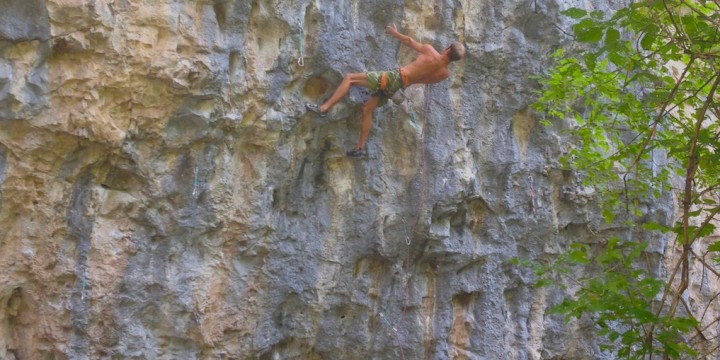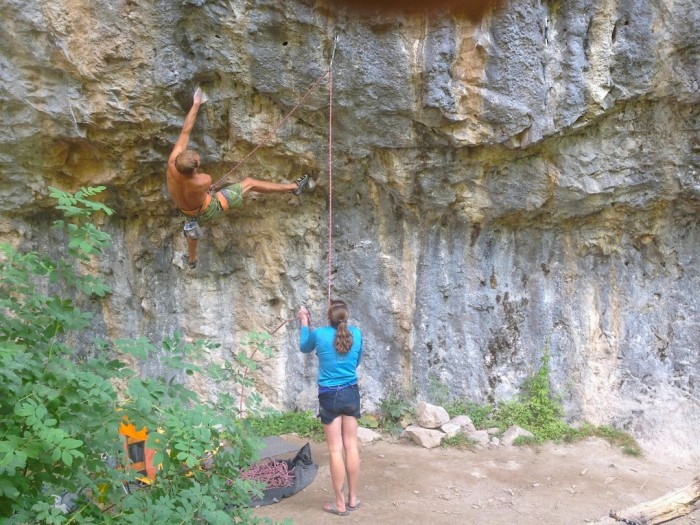
Belaying Someone Twice Your Weight
Hi Steph!
My name is Emily from California by way of Seattle. I’ve been climbing since I was a teenager and admiring your writing and your climbs basically as long. I’m also a lover of dogs–the photo of you and Fletch was the reason I picked up your first book. 🙂 I have a kind of weirdly specific question – I hope you don’t mind me asking – but I thought I’d write and ask your advice. Maybe some of your other readers are in a similar position!
The situation is: my partner learned to climb in the past few years and we had an awesome summer of climbing planned out. He learned to lead this year and has been training in the gym. The problem is we have a huge weight difference – almost 100 lbs – and I’m not sure I can belay him safely when he’s leading. We tested this out in the gym, with him taking a planned fall from above the last clip, and he would have pulled me to the first clip if our backup belayer hadn’t stomped on the rope. One solution is for me to just lead all summer, but he’s so enthusiastic and psyched about everything he’s learning that I think it would be a shame for him not to be able to do awesome (but safe!) stuff outside. For belaying single-pitch sport climbs, my inclination is to throw some rocks in my backpack to make myself heavier and build myself a loose anchor so that I can give him a controlled catch without flying all the way to the first clip, but I’ve been reading up online and it seems many people think anchoring the lead belayer is always a bad idea. I’ve always climbed with partners bigger than myself and I can catch someone who’s probably 70 lbs. heavier than me with confidence, but 100 lbs. without some backup spooks me. What do you think? I know there are some great and tiny female climbers out there – what do they do?Thank you for your thoughts and for being a climbing and writing inspiration!
Emily
Ps. Here’s a picture of my partners, Isaac and RB the dog – maybe a distant cousin of Cajun 😉
Hi Emily,
I never thought of your idea before, of putting rocks in your backpack, and it seems pretty clever. If you do still get yanked, though, it could be kind of unpleasant with a pack full of rocks on your back. But it did make me think it could be really nice to wear a weight belt to make yourself a little heavier while you belay, unfortunately this would only be realistic at a place like Rifle where you have a 4 second approach, because who wants to carry a 30 pound diving weight belt up to the crag.
Here are some thoughts for things you might want to consider trying:
-When I’m belaying someone significantly heavier who is likely to whip, I make sure I’m standing directly under the first bolt or piece.
-I also make sure I’m wearing solid approach shoes, laced up, rather than sandals or clogs.
-I think it’s a very good idea to anchor yourself (but it can be challenging to find an anchor that’s exactly where you want it: i.e., directly under you while you are standing almost directly under the first piece). Still, I would take an anchor that is a little off to the side or back over no anchor.
-I would recommend that your partner stickclip the second bolt when you are belaying him, to avoid a potential ground fall and the dreaded dingdong effect where he falls at the first bolt and pulls you up and you smack into each other.
-Use a grigri.
-Have someone stand next to you who is ready to grab you when your partner falls (requires full attention from both of you).
-Make your partner lose weight, and you eat lots of cookies 😉
I’d really like to hear from other small/big partner combos out there, to see what ideas other people have come up with too.
Have a great trip…and no dingdongs or groundfalls.
Steph










For the first pitch I would follow Steph’s advice. After the first pitch, I would use this : http://vimeo.com/44869774 Have fun!
I started trad climbing first so I have always anchored in when belaying. When I moved to the midwest and went climbing with a bunch of sport climbers, I tried to anchor in and like 10 people _ran_ up to me to told me no, because the climber would break his spine if I did that. Really?! I caught many falls and fallen many times on multipitch routes, where the belayer is by nature anchored in, and I have always been fine. By that logic, trad climbers all have broken their spine at some point. Surely enough, when the climber whipped off the wall I got pulled up and into a small roof near where I was belaying. And it hurt. A lot.
My girlfriend and I have a 70lb-80lb weight difference, depending on both of our diet and exercise levels for that time. I was climbing on an overhanging route once and I fell. She was not anchored in. I fell like 40 feet and only stopped because her belay device jammed against the first draw, 12 feet high! I would have kept going for sure if not for the first bolt. The biner jammed the handle of the grigri so she couldn’t even lower herself and if people were not around to help it might have been a stressful situation.
(Come to think of it, the biner could potentially override the grigri’s camming action… hmmm.)
This past weekend I also fell, not as high above my last piece and my girlfriend was anchored in. I still fell like 10-12 feet, past 2 more bolts and it was as soft as a feather. The rope stretch took care of all of that. No need for fancy jumping or whatever to “soften” the catch. That’s why we climb with dynamic ropes and not static. 🙂
That said, I have learned a thing or two from sport climbing and I will give a dynamic catch if it is safe to do so, depending on the climber and the terrain. Some gyms now require you to know how to give a dynamic belay in order to pass their lead cert. test and I think that’s good and bad. These are the same gyms where it is okay to stand 40 feet from the base of the climb so you can “see” your climber.
I’ve been climbing for 10 years, and my other half for 12 – I weigh 8st, he 14st, so there’s a big weight difference. For me it’s all about confidence – I don’t use an anchor as I find it restricts me and prevents giving him a dynamic belay. When we got together it took a while to get used to the weight difference and ensure that we were both comfortable with my belaying, but I’ve found that I can hold the majority of his falls and stay on my feet, and cases where I do go for a bit of a flying lesson I’m still completely in control. It helps that I use a Gri Gri, as it just eases some of the pressure and allows me to know that if the worst was to happen and I were to let go I have some sort of back up. It’s all about practise and getting used to each other’s style. Weight differences are inevitable, but they can be controlled just as safely with the right technique.
Whenever I have this situation I prefer to make a loose anchor. As for situations where the only usable features off to the side, I have sometimes made an oppositional anchor, with two features that are off from the line of the first bolt. It might be overkill for some, but at least I know the direction and distance I will go if/when I get pulled up.
My boyfriend tells me that I never have the pleasure of belaying a “light” climber. My climbing friends are 60 to 100+ pounds heaver than me. I’ll share what works for me.
When I am climbing in a gym,I have my climber undo the first clip once they reach the second. In the gym it is easier to do because the draws are closer together. Also, I never ground anchor in. I hate being constricted and not able to move around. When anchored to the ground I can not run backwards to quickly take up slack. Instead I do not belay someone who is over 170 pounds. In the gym setting, there are always many lead climbers that are wiling to give a belay when I can not. I always use a gri gri.
Outside, I fill my bag up with gear that is not being used and I attach a sling to the bag and myself. Just 10-15 extra pounds makes a great difference for me.I am also able to move around, unlike an indoor ground anchor. Every time I climb outside I will not belay anyone over 180. Even with a anchor system, it stills puts myself and my climber at risk. I try to go with a group of 3 or 4 climbers so nobody will be stuck with out a belay.
I have the same issue too….light climber often belaying people 60+ lbs heavier. I have a made a ‘dynamic’ tie-down….basically a length of tubular webbing, with a couple of strands of bungy cord inside, with it all tied into a knot at either end. It is a bit hard to describe…..but the webbing is essentially ‘scrunched’ up around the bungy so that it has room to extend, but at some point I’ll hit the ‘end’ of the stretch (and the webbing takes over) and that will limit how far I go up when my climber falls. I don’t use it in all situations, but when I do I just anchor myself to a convenient point (tree, rock etc) or to my pack filled with rocks. I can still give a dynamic belay and move around which is nice, and it is light enough to just always keep in my cragging pack for when I need it. I used to just tie myself loosely to a pack filled with rocks, but I find the bungy is easier to set up and is a lot more comfortable (for me) when the climber falls.
For multi-pitching….I second the fixed-point belay option.
On a related note, when belaying from above, belay your partner through the anchor whenever possible (i.e. safe). This may mean carrying extra webbing to extend anchors, or bringing material to pad the lip, but is well worth the trouble. Use an auto-blocking device directly on the anchor, or redirect the rope through the anchor where appropriate, and you’ll be much happier. Holding that 100# difference on your hips is BRUTAL when your partner hangdogs.
Poached, I have the same story learning on trad then moving to the midwest where tying-in is frowned upon (esp at the newer crags at The Red). But one of the 1st climbers I was belaying had a good 80lbs on me and I used my system of webbing around a tree a good distance away. I keep the webbing extremely loose, basically enough just play in the system to save me from being pulled to the first bolt. He fell from the anchors and that webbing was definitely what saved us.
I also am a big advocate of a helmet! Your head/face can easily be saved from a falling foot or a pull into the wall. A little bit of annoyance (heat, etc) can go a long way, esp if you have a tendency to put your arm up to protect your head.
Not the best option, but one thing to keep in mind- be friendly with other duos/groups at the crag who look like they are in a similar situation. The smaller stranger might also appreciate swapping partners for at least one route for a little less belaying stress!
Thank you Steph and everyone for your suggestions! Really, really helpful!
If possible and convenient in the climbing situation you can try to increase the friction by e.g. clipping a bolt of the route next to yours or place gear a bit off the line of the bolts… this extra friction will decrease the impact force!
Philipp
I’ve had good success with clipping a light pack (with whatever random gear is left) directly to my belay loop. Makes it a little awkward to move around but I can move a 20-30 pound pack pretty easily and the extra weight keeps me from visiting the first bolt or feature at Mach speed. 🙂
Hi Guys,
I am in the same situation with my wife as we do have 45 lbs difference and we are both beginners. I have been thinking about an idea to make it safer for both of us when I lead climb but I am not sure this is a good idea. Here is the idea: instead of carrying a backpack full of stones, I think we can have a backpack full of stones on the ground and then tie a rope from the backpack to the harness with a short rope, just giving enough room to move a bit around the backpack. Of course, the rope should be shorter than the distance between the lead belayer and the first bolt. One can consider this as an anchor but if you balance the weight in the backpack properly, this setup should give a softer fall for the lead climber as this will be a kind of dynamic belay.
Does that make any sense of this is a stupid and dangerous idea?
Thanks for your comments.
I have used a technique similar to what you describe when I belay at an indoor gym- Single pulley belay with GriGri, I tie a free weight or two to my harness and place them a few feet away. It’s not fun asking “How much do you weigh”, and adding weight to make us about equal, but it is much safer than flying upward until the mass evens out on the pulley! Thanks physics! When they do fall using this system I only come off the ground the length of the counterweight rope, since they replaced the gym floor and took out the D-rings, this was the best I could come up with… but it has worked fine since.
yes !
Thanks for the great idea! Could you explain exactly how you tie the free weight to the harness? Like, on which loop and what kind of knot? Thanks!
Make sure you clip the weight directly to the belay loop–a figure 8, an overhand, or a bowline would all work fine. Just watch your toes!
I’ve been climbing with someone who’s almost half my weight for a while now and we tend to prefer not to anchor, but it really depend’s on the climb. If the climb is within my onsight grade or not too run out, there’s no issue with her being lifted up so we belay as normal. On the other hand if her being pulled up could cause me deck out we go for either a 10kg weight vest that we use for training (if there’s a short easy approach) and I still get a nice soft catch. Or we loosely anchor in using a short dynamic line, connected to her belay loop. Hope that helps 🙂
Exactly what Steph said, one day before we got the extra length of rope for this I used a long thin rope that was daisy chained up in the closet. I looped a larks head knot through the hole in the weight then looped both into a(double) figure 8, with enough length to make a loop for the clip and trace the knot with both thin ropes. It ends up like a quadruple figure 8 when you use thinner rope to dangle the weights. What I recommend though, because it is less contrived and probably a bit safer- is just to use a short length of actual climbing rope, I just have to work with what they give me sometimes…
Hello, I’m in a similar situation, a guy that gave us a lead climbing class mentioned for us that there was a device designed for this purpose, I forgot the name of it and couldn’t find it for a while until now, it is made by Eldelrid and it’s called OHM , Edelrid OHM .
You basically clip it to the first quickdraw and the leader passes his rope trough it , in case of a fall it tightens the rope kid of similar to a GriGri , but in this case you’re using the anchor to help you with the weight to stop the fall .
It does seem kind of costly to me , but I guess it can be worth it… Search for it on youtube
Thanks for the tip: definitely an interesting device!